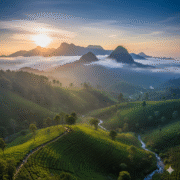
Discover Ritigala: a mountain where history and legends meet.
- November 13, 2025
- eunoialankatours
- 5:56 pm
Picture a mountain in Sri Lanka’s Cultural Triangle where mist covers the slopes and hides ancient stone paths, austere monastic ruins, and stories that are older than written history. The Ritigala mountain range rises sharply from the dry plains, 43 km northwest of Anuradhapura and off the beaten path for tourists. The highest peak, Ritigala Kanda, is 766 meters above sea level. It is the highest point between the central hills of Sri Lanka and the mountains of South India.
Even though it is in a dry area, the summit has a unique microclimate that makes it much cooler and wetter than the plains. During the monsoon, mist and rain clouds cover the peak, making the ground wet while the countryside below suffers from drought.
A Mountain with Many Names and Tales
Ritigala is one of the oldest names for a place in Sri Lanka. Old records call it Ariṭṭha Pabbata, which means “dreadful rock” or “safe rock.” Another story says that the name comes from the riti tree, which has a straight trunk and still grows on the slopes. People have told stories for generations about aboriginal yakkas (spirits) who protected the mountain and King Pandukabhaya who sought shelter here in the 3rd century BCE. Brahmi script was used by monks to write on caves in the 1st century BC, making it the oldest written record.
The Ramayana and Myth
Ritigala is also mentioned in India’s epic poem, the Ramayana. The story goes that the monkey god Hanuman was sent to the Himalayas to get herbs that would save Prince Laxmana’s life after he was badly hurt in the battle in Lanka. He couldn’t tell which ones they were, so he brought back an entire mountain. People say that a piece fell from his hands and landed here while he was flying over Lanka. This tale explains why Ritigala has such lush plants and unique medicinal plants in the heart of the dry zone.
The Heritage of Ascetic Monks
Starting in the 3rd century BC, Ritigala became a place where monks could go to be alone. The strict Pamsukulika monks, who wore robes made from funeral shrouds, lived here. King Sena I gave a lot of money to build a big monastery complex on the eastern slope in the 9th century.
There are no stupas or Bodhi trees like in most Buddhist temples. Instead, the ruins show how simple things used to be.
- The first thing visitors see is the Banda Pokuna reservoir, a man-made bathing tank with a circumference of 366 m. It may have been built by King Pandukabhaya.
- A stone stairway leads to a well-made path that winds through huge rocks and tall trees.
- There are strange “double-platform” structures (padhanaghara) along the way. These are pairs of raised stone terraces connected by bridges and lined up east-west. They are thought to have been used for meditation, teaching, or ceremonies.
- The remains of a hospital are also there, and the grinding stones and Ayurvedic oil baths suggest that the healing practices were very advanced.
- Decorated urinal stones are some of the strangest artefacts. Scholars think the monks used them as a way to say no to elaborate religious ceremonies.
🌿 The Strict Nature Reserve, Flora, and Fauna
The variety of life on Ritigala is amazing. There are three different types of forests on the mountain range: dry mixed evergreen forest at the bottom, tropical montane forest in the middle, and upper montane forest near the top. The area was proclaimed a Strict Nature Reserve in 1941 to safeguard its unique ecosystem.
Ritigala has tall evergreen trees, native orchids, and herbs that are thought to have healing properties, including those that are connected to the Hanuman legend. Deer, monkeys, wild boar, and many kinds of birds are some of the wildlife you can see. Elephants, leopards, and sloth bears live outside of the marked trails.
Going to Ritigala
To get to the ruins, you have to drive a short distance from Habarana or Ganewelpola to the entrance of the archaeological site (about 9 km off the main road). To avoid meeting wild elephants, visitors should get there early.
Once you’re inside, you’ll walk along stone paths that are shaded by old trees, cross stone bridges over bubbling streams, and explore sunken courtyards. The climb is not too hard, but it gives you peace and a look into Sri Lanka’s monastic past.
We at Eunoia Lanka Tours love to take travellers off the beaten path. Our guided trips to Ritigala include both responsible trekking and storytelling. As you walk through the ruins that are covered in moss, listen to stories about ascetic monks and guardian spirits, learn about rare medicinal plants, and take in the views of the jungle from all sides. Ritigala is more than just an archaeological site; it’s a living sanctuary where history, myth, and nature come together.


